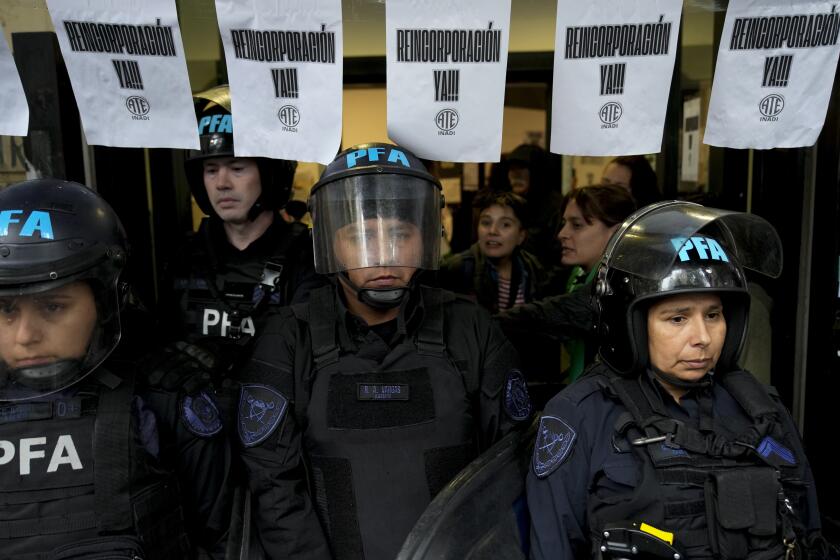Obama’s financial plan light on details
In unveiling President Obama’s long-promised strategy for reviving the nation’s moribund financial system, Treasury Secretary Timothy F. Geithner on Tuesday offered few details on such crucial issues as helping homeowners avoid foreclosure or clearing away the toxic securities at the heart of the banking crisis.
The dearth of details, which sent the stock market into a tailspin, reflects a double bind for the Obama administration.
Fixing the financial system has turned out to be a bigger, harder and much more expensive challenge than expected, potentially requiring billions more in additional federal commitments.
But the political climate has turned so sour that Congress, enraged by what it sees as irresponsible excesses by Wall Street executives, is unlikely to approve more funding, at least for now.
As a result, the administration is moving toward approaches that reduce the government’s financial risk and require no new congressional action. But those constraints mean the plans are taking longer to design and implement.
“What we did today was lay out the broad architecture of the programs we think are necessary to help solve this thing,” Geithner told members of the Senate Banking Committee after his morning speech at the Treasury Department.
A major element of the strategy calls for enlisting private investors to join a new public-private partnership that would buy $500 billion to $1 trillion in toxic mortgage-backed securities and other assets from banks and other financial institutions. The hope is that the financial sector, relieved of these risky holdings, will resume normal operations, supplying the everyday credit that is the lifeblood of the economy.
Geithner said the partnership would use an unspecified amount of already approved government funds, but he didn’t say how the plan would work except that it would employ a market mechanism for valuing the assets to be acquired.
The administration is “exploring a range of different options” and will seek the input of the public and market participants, he said.
“It’s good that they’re doing something about the toxic assets, but it’s very hard to evaluate the thing they are doing until they decide what it is,” said Douglas J. Elliott, an economic fellow at the Brookings Institution and a former investment banker. “There’s no question the market’s disappointed by the lack of details.”
The administration also envisions having the Treasury put up $100 billion to expand an existing Federal Reserve program aimed at spurring as much as $1 trillion in new consumer and business lending.
Those expenditures would be in addition to using the second half of the $700-billion financial rescue program enacted last fall to inject more money into large, struggling banks -- but with tighter oversight and more accountability than in the first half of the program, Geithner said.
Disappointed by what the Treasury secretary did and did not say, the stock market tumbled as he spoke. The Dow Jones industrial average fell almost 382 points, or 4.6%, to close at 7,888.88.
“Geithner appears well-intentioned and flexible, but ‘shock and awe’ this ain’t,” said Greg Valliere, a political strategist for financial services firm Stanford Group Co.
Underscoring the escalating price tag for pulling the nation out of its deep recession, the Senate on Tuesday approved an $838-billion economic stimulus package that some economists say still might not be enough to do the job.
The president traveled to Florida on Tuesday to rally support for the legislation, which faces difficult negotiations to reconcile it with a version passed by the House. Obama promised a Fort Myers crowd that his administration was going to help struggling homeowners, “not just banks.”
Geithner, however, provided little information on the administration’s long-awaited, $50-billion plan to reduce home foreclosures that is now scheduled to be unveiled in the next few weeks.
Rep. Barney Frank (D-Mass.), chairman of the House Financial Services Committee, said the administration was taking “too much time” developing a foreclosure plan and called on companies that hold or service mortgages to suspend foreclosure proceedings until it is released.
In unveiling the administration’s “financial stability plan,” Geithner sought to soothe anger in the public and Congress about the way the first installment of the $700 billion of bailout money had been spent.
The Treasury secretary acknowledged problems with the Bush administration’s strategy, which Geithner helped craft while serving as president of the Federal Reserve Bank of New York, and promised that the Obama team would do things differently.
“The spectacle of huge amounts of taxpayer money being provided to the same institutions that helped cause the crisis . . . added to public distrust,” Geithner said.
“Our challenge is much greater today because the American people have lost faith in the leaders of some of our financial institutions, and they are skeptical that their government has used taxpayers’ money in ways that will benefit them.”
Geithner said the Obama administration wouldn’t ask for more funds beyond the remaining $350 billion of bailout money until it was clear the government had a plan that was working, but he indicated that such a request would eventually come.
“I’m not standing here before you today to ask you to authorize more resources,” Geithner told the Senate panel. “I want to be candid, though, that I think this is going to be an expensive problem for the nation and it’s going to require substantial resources.”
Promising transparency for the financial rescue, Geithner said Americans would be able to track where the government money was going and how it was being used on a new website, FinancialStability.gov.
Federal Reserve Chairman Ben S. Bernanke also embraced transparency Tuesday, telling Frank’s House committee that the famously opaque central bank within weeks would launch a public website with information about the Fed’s lending and would review its disclosure policies.
In his speech, Geithner shed some light on the changes in store for the government’s program of injecting capital into financial institutions. He said regulators would conduct rigorous government reviews -- which he called stress tests -- of bank balance sheets. Institutions that are determined to need more capital would be eligible for an infusion from the government.
Officials said the examination would be mandatory for all banks with at least $100 billion in assets -- of which there are about 20 in the U.S. -- and would be designed to ensure not only that they were adequately capitalized but also could remain so during this period of economic stress.
Smaller banks would go through the stress test only if they sought fresh government funds.
Banks that get capital would have to provide a plan for how they intend to use it.
“The capital will come with conditions to help ensure that every dollar of assistance is used to generate a level of lending greater than what would have been possible in the absence of government support,” Geithner said.
--
maura.reynolds@latimes.com
Times staff writer Richard Simon in Washington contributed to this report.
More to Read
Start your day right
Sign up for Essential California for news, features and recommendations from the L.A. Times and beyond in your inbox six days a week.
You may occasionally receive promotional content from the Los Angeles Times.







